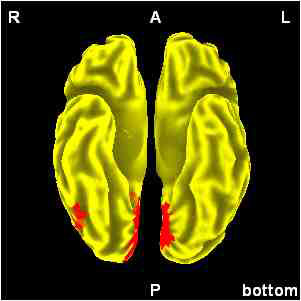Argument - Process - Physical Space - Psychological Aspects
Peripheral visionMuch of what happens in our peripheral field of view escapes our conscious awareness. We are, however, remarkably adept at automatically perceiving eccentrically presented objects-- we may not know there is a person at our shoulder, but we nevertheless turn to see who is there. Peripheral Agency explores this phenomenon by presenting stimuli on the edge of our visual field.

Faces play a unique role in human perception. We start looking for them from the moment we are born, they attract and hold our attention like no other image, and we recognize them with remarkable accuracy. Many researchers now believe that the brain possesses a distinct module for the perception of faces (the human fusiform face area, below). Peripheral Agency plays with the salience of faces by placing these irresistible targets outside of our reach.

The self
Peripheral agency pulls apart the mirror, separating the actual gaze from the virtual gaze. One is aware of the watcher and one is aware of the self, but one is denied the narcissistic satisfaction of seeing the self directly. This denial alludes to the shortcomings of self knowledge, the fact that much of human thought, feeling, and behavior occur beneath our consciousness.
Data
The data used in the rendering process will be collected for subsequent analysis. These data will be used to: a) map out common movement patterns, positions, and orientations of viewers throughout the space, b) examine the changes in these measures over time per individual viewer, and c) study the relationships between these measures and the uncanny quality of the virtual head.
Relevant Literature
Duval, S. & Wicklund, R.A. (1972) A theory of objective self awareness. Oxford, England: Academic Press.
Jonides, J., 1981. Voluntary versus automatic control over the mind's eye's movement. In: Long, J.B. and Baddeley, A.D., Editors, 1981. Attention and performance IX, Lawrence Erlbaum Associates, Hillsdale, NJ, pp. 187–203.
Kanwisher, N. (2000). Domain specificity in face perception. Nature Neuroscience, 3(8), 759-763.
Posner, M.I., 1980. Orienting of attention. Qualitative Journal of Experimental Psychology, 32, pp. 3–25.
Pusch, M. & Loomis, J. (2002) Judging another person’s facing direction using peripheral vision. Unpublished manuscript.